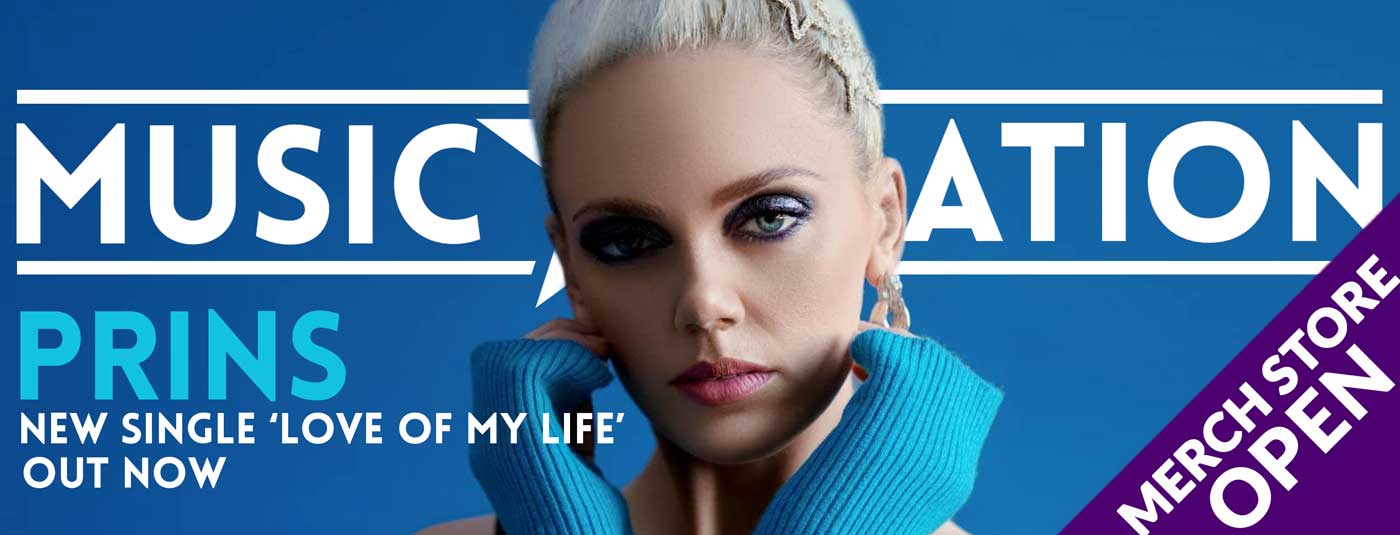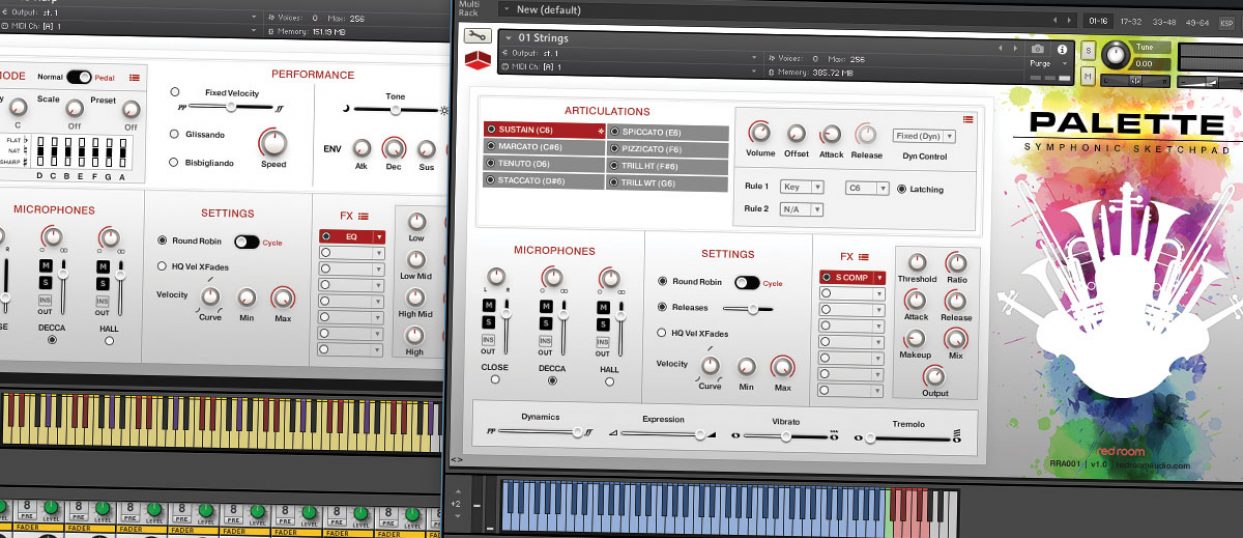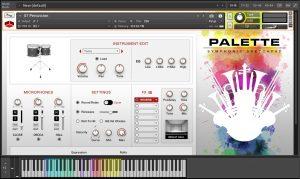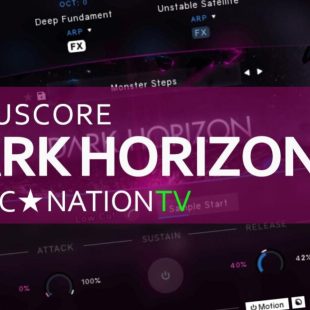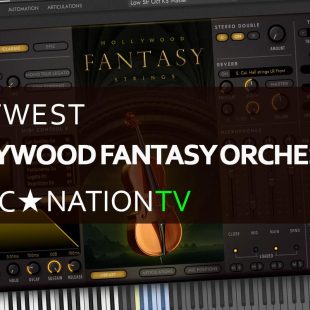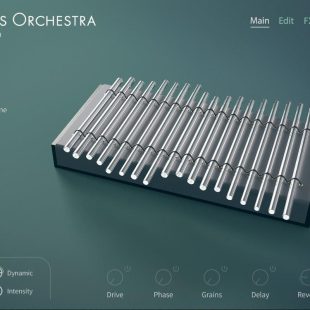Red Room Audio Palette – Jack of All Trades
Hello again, and welcome back to a new StudioWise review. This week we have a developer in our sights who has some serious backing, experience and know-how. Although it seems as though every man and his dog is releasing an orchestra-themed Kontakt library these days, few come packaged as a total composing toolkit.
But is that enough to elevate Red Room Audio’s Palette above the rabble?
We receive so many orchestral libraries to review at Music Nation it’s getting hard to be subjective any more due to the consistently extremely high quality. Developers these days have all the basics sorted with their libraries and reviews become more a discussion on the usability and flexibility more than the sound quality.
Overview
Palette is a collection of four individual orchestral packs tied together by the flagship ‘Symphonic Sketchpad’ core library. The Sketchpad library is the starting kit, with the extra brush packs optional expansions to enhance the palette – hence the whole ‘palette and brushes’ metaphor. The core Sketchpad library retails at $299 USD, with each of the three brush packs coming in at $199 USD. A fourth bonus ‘Percussion snaps, claps, slaps, stomps and shouts’ mini-library is available as a freebie.
Palette with all the brush packs installed clocks in at around 65 gigabytes, runs on the free version of Kontakt and features a minimalistic red-on-white interface – with a slight Star Wars vibe as I thought when I first saw it. If that was intentional or not, it’s cool with me and I think it looks great.
The full-width interface features nice watercolour artwork covering nearly a third of the interface, which looks nice but serves no purpose other than cosmetic. This can be disabled if you prefer the compact style.
Palette’s main point of difference is the unique recording process. Unlike a traditional orchestral recording session where musicians record in sections, Palette was recorded as an ensemble. The difficult process requires the entire section to sit there in absolute silence as each and every articulation, round-robin and dynamic layer is recorded. However, the benefit of the process is that instruments sound more connected because they were all recorded next to each other in the same environment and the overlapping ranges sound more lifelike. This works because as each instrument encroaches into the next, say for instance the basses into the cellos, there is a range of notes that both instruments are playing, hence the recording mics will capture these very specific overtones and harmonics.
And then, just to really drive all the players nuts, they recorded everything over again with a smaller chamber ensemble for a tighter sound option. So you’re getting two complete orchestral recordings with a bunch of incidental solo instruments and effects, all recorded in the same room.
The full breakdown for each of the orchestral sections is as follows:
Full orchestra |
Chamber orchestra |
|---|---|
| Strings: 12 x 1st Violins 10 x 2nd Violins 8 x Violas 6 x Celli 4 x Double BassesBrass: 3 x Trumpets 3 x Horns 3 x Tenor Trombones 3 x Bass TrombonesWoodwinds: Piccolo 2 x Flutes 3 x Oboes 3 x Clarinets 3 x Bassoons | Strings: 12 x 1st Violins 5 x 2nd Violins 4 x Violas 3 x Celli 2 x Double BassesBrass: 2 x Trumpets 2 x Horns 2 x Tenor Trombones 1 x Bass TromboneWoodwinds: 1 x Flute 1 x Oboe 1 x Clarinet 1 x Bassoon |
And, of course, because these are all unique recordings from the same studio environment, you can safely layer both full and chamber variations together to create an even larger-sounding band. Quite clever stuff.
Roadtest
There is no automated installer but each of the Kontakt-based libraries is fairly straightforward to download and set up if you follow the instructions. Once installed and authorised by your Native Access software, you should see the new addition to your Kontakt collection in the browser.
Upon opening you will see all of the necessary controls present on the screen laid out in an intuitive way. Controls include a bright articulations readout on the top left corner showing currently enabled options and allowing you to disable unused samples to preserve processing resources. Next to that is the MIDI dynamics section for adjusting basic controls like volume, attack and release values. Under that is the effect rack, allowing up to 8 insertable plugins, each with its own micro controls.
A velocity and round-robin controls section is included for fine-tuning the playback feel and realism. A three-channel microphone mixer features typical mute, solo and pan controls, plus you can define specific outputs to your DAW and disable unused channels again to preserve RAM.
At the bottom of the interface are your typical performance controls, each with a slider that you can map to your MIDI controller. The dynamics and expression are pre-mapped to cc 1 and 11 as expected, with the handy vibrato and tremolo controls mapped to 4 and 2 respectively.
The individual solo patches, such as piano, harp and trailer tools, have slight variations to the UI to account for the instrument, but in general, everything is well laid out and shares the familiar workflow and design.
The Sound
What is immediately noticeable, especially if you are used to other orchestral library collections, is that Palette is in general very dry sounding. Though there are both Decca stage and full hall outrigger microphone recordings, the sound is clearly a studio recording, and what I would call ‘intimate’ sounding.
There are three main groups in the core Sketchpad library – strings, woodwinds and brass, each offering smaller chamber alternatives. All six patches offer the same 3-channel microphone options including close, stage Decca tree and hall.
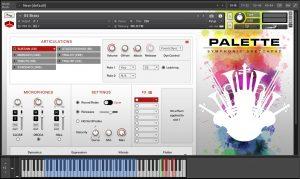
Starting with the strings, and I’m going to get quite picky here, there are some odd balancing issues for me with the close mic recordings. There is a strong shift to the left with the recordings, whether or not that has something to do with the room and the players’ seating, but it’s quite noticeable as most instruments are either centre or centre-left of the soundstage. It’s made more pronounced once you bring in the Decca and hall channels, you hear a distinct shift from left to full-centred. I don’t think it’s an error or sloppy recording techniques, probably more just a natural quirk of the studio space, but it is something you will need to account for if you’re mostly using close recordings in your arrangements.
I’m not, however, a fan of the seating arrangement of the string section. The basses are stage right with the violins stage left, so from an audience perspective, everything is backwards. Unfortunately, you cannot pan around individual elements in the ensemble, of course, because it’s recorded as a complete orchestra.
Ambience
The stage Decca tree mics add nice width and ambience to the strings, though oddly the hall mics add only slightly more distance to the mix, which is a little disappointing. When combining the Decca and hall together, to me it sounds more like just an increase in the volume with no added depth. In fact, if you drop the Decca mic level by about 5db, there is audibly very little difference between the two.
The string patches (both full orchestral and chamber) are quite lively and responsive and react well to the dynamic controls. For some reason though, perhaps a bug, the marcato articulation holds the note after you’ve released the key. In fact, I experienced held notes often when working on the review, particularly when triggering multiple articulation styles at once. Thankfully, Kontakt has an easy-to-click ‘!’ button for choking stuck notes.
The included effect rack, in general, is quite average. Since the recordings tend to be somewhat dry, this is a great opportunity for adding studio effects to artificially widen or to bring in a more controllable ambience to the sound. Unfortunately, the default reverb is, quite frankly, terrible. Literally, anything else is better, even the built-in reverb that comes with our DAW. When processed with quality 3rd party plugins such as FabFilters Pro-R or UVI’s Sparkverb the orchestra springs to life.
There are a lot of effect plugins included, all of which either sound average or are completely inappropriate for an orchestral environment – such as guitar amp cabinet simulators, rotary cabinets and screamer distortion effects (!!). Perhaps a sound designer may experiment with these if they were desperate, but on the whole, the effects rack should be avoided.
Character
Back to working through the string articulations again, I particularly like the staccato and spiccato recordings. They are, by default, a little slow in responding to the touch, but a slight tweak on the velocity gives you more attack.
The longs are nice and gritty, again a little slow in the attack, but easily modified to suit your requirements. As mentioned, the marcato articulations hold notes after you release the keys, this happens on all patches that have a marcato option. I cannot guess why this is a ‘feature’, but for me, it makes the articulation totally unusable.
I found the Tenuto has some trouble with the release tails being cut off unnaturally sometimes, though this again is fixed by extending the release slider. The pizzicatos are a little too delicate for my taste, but they sound nice. Even with more velocity curve and EQ added, the lack of bite. The half and whole-step trills are fantastic, and surprisingly playable, unlike many other attempts I’ve seen to replicate this effect.
Though on the whole, the string sound is somewhat underwhelming as individual patches, you can achieve some huge sounding setups by layering both full and chamber orchestral patches and applying some tasty external processing and reverb. I very much like this approach as you have much more control over the scale of your sound.
Moving on through the woodwinds and brass patches results in similar findings. Very dry and slightly underwhelming microphone recordings, a nice selection of articulations (with the same held marcato notes), and alas, the same pointless effects rack.
The brass full and chamber recordings are the most successful of the three for me, sounding very well balanced as you would expect from the back row of an orchestra. The Decca and hall mic recordings are much more effective with the brass instruments due to the highly transient nature of the instrument reverberating off the studio walls. The dynamics feel right on point too when playing, even on a MIDI piano – I would love to try using a breath controller one day – I think it would be a perfect match.
The woodwind instruments are traditionally seated very centrally in the band, however, the close mic positions sound very mono. They are not mono – I checked – but they are certainly not wide at all, which gives the impression the bassoonist, flautist and clarinettist are all sitting in a very tight group around a single mic. Again, layering and processing reward you with much more options over other libraries, and as part of a bigger picture with the string and brass all together, the woodwinds are central and perfectly balanced.
So other than some unusual seating position in the string section, the core three ensembles have a grittier and more raw sound than what I’m used to, with much less ambience than other libraries. The full ensembles are not thin, but certainly not huge in default microphone mix positions, but with simple layering and post-processing you have a lot more flexibility between small and tight sections through to pure bombastic Hollywood cinematics.
Solo Instruments
In addition to the main string, brass and woodwind sections, Palette Sketchpad offers 10 extra auxiliary supporting instrument patches. The percussion category is extremely good. Though there is only a handful of instruments included, they are on the whole very playable, especially with the clever dedicated piano note that repeats the last note you played, which makes double-fingered drum rolls much easier. The room mics are much more effective here too, you can really hear the fantastic room ambience on the Decca and hall settings, wonderful stuff.
The Timpani is one of the best implementations of the instrument I’ve heard for a while. Being split over three zones on your keyboard, it is very playable and allows you to detune and add rolls on the fly.
The concert harp is again very nice and goes slightly sharp when you hit the keys hard as you would expect on the real instrument. A nice touch there. Being one of the more cleverly constructed patches, you have a wide range of controls over the performance of the instrument. A glissando can be set in any key between two notes held on the keyboard which I’ve not seen done before.
The included grand piano is extremely playable. I really like the dynamic range, and since they recorded this in the same hall as the other orchestral instruments, it sits beautifully with the other instruments in the library. You have loads of ambient options with the mic mixer and a cool little slider for dark and light tones. I could take or leave the brighter sound, but the darker one is wonderful, especially with a little more pedal noise added. The instrument has an ever so slightly mistuned tone, which I love about it. You very rarely run across a freshly tuned concert piano in real life, so this is another nice little detail that helps bring character to the library.
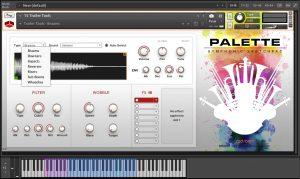
It’s nice to see a choir patch included, and though it’s a rather simple offering next to dedicated behemoths such as EastWest Hollywood Choirs, there’s a good selection of articulations covering your typical ‘Mmmm’, ‘Ahhh’ and ‘Eeee’ patches, both male and female choruses. No phonetic worldbuilders here, of course, but again a worthy inclusion to the library.
A handy Trailer Tools contains a collection of bams, drops, hits and risers that are trendy right now, and pure Hollywood overkill. And finally, a nice little subtractive synth which is fairly rudimentary, though some useable stuff can be found after a bit of digging around. There is a nice selection of presets, but it’s not too difficult to come up with some very usable sounds by just fiddling with each of the oscillator controls. Clearly, these two patches are aimed at the sound designers, but there’s no reason traditional composers can’t include some modern elements to enhance or fill out the frequency spectrum, so these are certainly nice little additions to the library.
Performance
On the whole, Palette comes with very frugal and well-optimised samples, which is odd because the performance can be a little choppy at times, depending on the instances you have running.
Patches also take longer to load than expected, considering the small patch sizes. Even after a full batch re-save the main string patches tend to take 30-40 seconds to load, and even longer if you include all three mic recording positions. It’s not long enough to make a cup of tea, but certainly, enough time to check your emails! By comparison, the full ensemble string patch weighs in at only 385 megabytes with all the articulations loaded and takes about 40 seconds to load, whereas Native Instruments String Ensembles with double the RAM footprint load in around 10 seconds.
In general, the entire library feels a little sluggish, and I can’t quite put my finger on whether it is poor optimisation or slightly lose samples. Much can be ‘fixed’ by playing with the velocity curves, but it still feels just a little too lazy.
Brush Packs
In addition to the core sketchpad library, a selection of expansion packs called Brushes is available. Each contains tailored embellishments to accompany the main library and as such would not make sense as stand-alone purchases.
Pack 1 is called Melodics and contains a selection of solo and dual instrument patches, such as cello and bass, oboe and bassoon, tuba and trombone etc, and solo lead instruments such as violin, oboe, cello and trumpet. Each is quite playable as a soloist’s performance thanks to the legato articulation included. The Melodics brush pack patches are in general more aggressive and upfront than those in the core Sketchpad library, and so they are more suited to solo lines and specialised arrangements.
The solo instruments have a nice tone, but in my opinion, they are not overly characterful. You have standard dynamics and vibrato, but nothing as expressive, for instance, as Embertone’s soloist libraries.
Brush pack 2 is Orchestral FX, a weird collection played by each of the string, brass, woodwind and choir sections. The string section is quite effective with short and long effects, but it is the choir section that is really quite excellent, with way too many very disturbing textures and vocal tricks, brilliant stuff. These are all looped phrases with the same sample loop controls as Sketchpad’s Trailer Tools patch, so setting up phrase loops is simple. Each blue key on the display is a separate performance phrase, with the red keys defining the category, from shorts, longs, rises and falls etc.
Oddly, none of the phrases is time synced to your DAW, so aligning a sample with your arrangement is mostly done using dumb luck. Samples cannot be dragged out of the player into your DAW for processing, which feels a bit stingy on the part of the developer, as pretty much all such sample loopers allow this basic operation. You’re left to guess the start and end points to get your loop in time. Not a big deal for one-shots, but a major pain in the butt for anything looping.
The included Orchestral FX Builder is loads of fun, and definitely the highlight of the pack. The builder contains four sample players, each with tuning, start and stop editing and volume control. Drop a unique phrase loop into each player then offset the start time, pan and loop settings for some really crazy results. You can, for example, set the first loop as a riser, then start the second sample as the riser ends, and then loop that with the remaining samples coming in at different times through the loop. Lots of fun.
Finally, pack 3 is Runs and Arps, and no surprises here contains a selection of prerecorded scales and arpeggios as phrase loops. Each of the prerecorded phrases features a single octave pitch selector and articulation switches. The standard 3-microphone mixer is present, dynamic effects and our old friend the effects rack. You only have a choice between string or woodwind patches, each with just 7 articulations, which feels a bit miserable considering that the price is the same as the others in the series.
Conclusion
Palette Symphonic Sketchpad and expansion brush packs are a well-curated and thought-out collective for both traditional scoring and sound design. It has a nice workflow, an attractive interface and intuitive controls.
The core function is the all-in-one recording technique used, mostly with great success. There is a vast array of instruments included and all sit well together as an ensemble, and sound even better and bigger if they are layered. The drier recording technique offers a lot of flexibility for ambience control, though the woeful effects rack needs to be either updated or removed entirely.
There are some concerns with loading times, maybe some optimization could be applied here, and one or two bugs in the articulation marred an otherwise fantastic workflow.
The entire Palette collection has a quite close and raw quality to the sound, somewhat understated. There is little of the lush pillowy Spitfire Albion sound here, nor any of the larger-than-life Cinesample/ EastWest Hollywood Strings bombastic tones – you can certainly get that sound by layering, but more importantly, you’re not stuck with only that one sound.
The biggest barrier for most will be the rather eye-watering price. At US$299 for the core Sketchpad, then US$199 for each brush pack, you are up around $900 USD for the complete palette, which is very expensive next to UVI’s $199 Symphonic Strings, Native Instruments Komplete 11 at $599 and even the mighty Spitfire Audio Albion One at $799, which is considered purely for the no-expense-spared professionals out there.
I’m not convinced all of the Brush packs offer good value either. Each retails at US$199 and only offers slight embellishments to the core Sketchpad. Red Room Audio offers a 5% discount for each pack you buy as a collection, but wow you are still way in the upper echelon.
The reasoning here, I’m sure, is you can pick and choose packs as you need or can afford. But the other angle is this looks like a cut-down core product with up-sell DLCs.
This review is based on the total Palette ‘experience’, Brush packs and all, which I’m afraid missed the value for money mark by a country mile. In a very crowded and competitive market sector, I think that releasing an introduction product from a new developer at such a price is certainly audacious.
